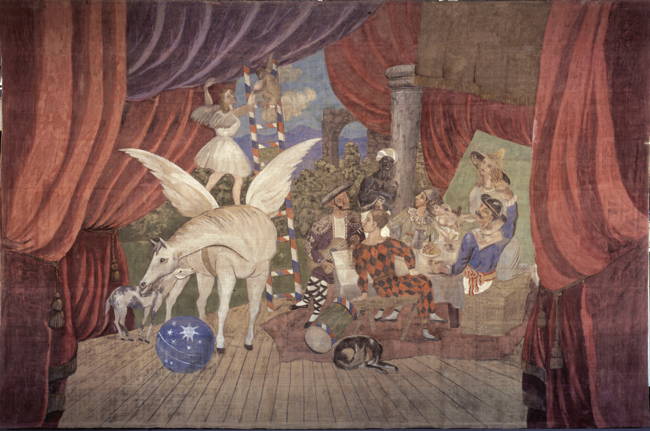
Pablo Picasso, curtain for Parade, 1917, tempera on canvas, 1050x1640 cm. Paris, Centre Pompidou - Musée national d'art moderne - Centre de création industrielle Photo © Centre Pompidou, MNAM-CCI, Dist. RMN-Grand Palais/Christian Bahier/Philippe Migeat © Succession Picasso by SIAE 2017. |
Together with Jean Cocteau, Picasso came to Italy to work with the Ballets Russes on Parade, a ballet that would hit the stage in Paris in the May of 1917, to an idea of the same Cocteau and music by Erik Satie. During his visit to our country the artist came to Naples twice, between the March and April of 1917, and Pompeii.
13th March 1917: "We are [Picasso, Sergej Diagilev and Massine] once again in Rome after a trip to Naples, and from there to Pompeii by car. I do believe that no city in all the world could please me more than Naples. The teeming classical antiquity, brand new, in this Arab Montmartre, in this great mess of a kermesse that never stops. Food, God and fornication, here are the drives of this novel people. Vesuvius crafts all the clouds of the world. The sea is dark blue. Hyacinths hurl themselves on the pavements"
(Jean Cocteau, Lettres à sa mère, I, 1898-1918, Paris, Gallimard, 1989)
The exhibition will allow emphasis on the importance of the direct meeting of Picasso with antiquity at Pompeii, and above all with traditional Neapolitan culture, in an entirely new dimension of Picassoan studies, through some of its greatest expression - the Presepe, popular theatre and marionette theatre. With Parade, the cubist painter returns to his first source of inspiration tied to the world of the circus, also renewing interest in the classic tradition, later recalled by Cocteau in his “Call to Order".
The Royal Palace of Capodimonte will host the Parade curtain in her ballroom. The largest work of Picasso, of utmost importance for modern art, will be in Naples for the first time. A canvas of 17 metres wide by 10 metres high, kept at the George Pompidou Centre of Paris but, due to its size, displayed only on rare occasions - at the Brooklyn Museum (New York 1984); at Palazzo della Gran Guardia (Verona 1990); at Palazzo Grassi (Venice 1998) and at the Pompidou Centre of Metz (2012-2013). The work will be accompanied in the exhibition by a wide selection of works by the Spanish painter. To further investigate the relationship of Picasso with the theatre and Neapolitan tradition, Capodimonte will also host the sketches produced by the artist for the ballet Pulcinella (staged in 1920 in Paris with the music of Stravinsky and the choreography of Massine) together with certain marionettes and puppets from Neapolitan maschera from the Fundación Almine y Bernard Ruiz-Picasso para el Arte collection.
The Antiquarium of Pompeii will welcome the ballet costumes designed by the artist, who visited Pompeii in March 1917. To confirm the influence of theatrical iconography on the art of Picasso and to celebrate his passion for the maschera, the costumes will be compared alongside a collection of African masks, along with a selection of archaeological finds from the site, including a group of theatrical masks, for the most part never seen before (antefixes, embossed plates, herms and statues). The innovative comparison between the ancient references and “art nègre” is underlined at Pompeii by the magnificent sketch of the 'poster painting of Cubism' Les Demoiselles d’Avignon painted in 1907 and exhibited for the first time to great fanfare in 1916.
This Summer on the 27th, 28th and 29th July, the Large Theatre of Pompeii will host two ballets with the choreography of Leonide Massine: Parade with music by Erik Satie and Pulcinella with music by Stravinsky, both portrayed by prima ballerinas, soloists and the corps de ballet of the Rome Opera House.
The works on display hail from different museums and private collections, including the Musée National d'Art Moderne, the Centre Georges Pompidou, the Musée Picasso Paris, the Museu Picasso Barcellona, la Fondation Pierre Bergé-Yves Saint Laurent, la Bibliothèque Historique de la Ville de Paris, la Maison Jean Cocteau, Milly la Forêt, la Fundación Almine y Bernard Ruiz-Picasso para el Arte (FABA), the Mart Museum of Modern and Contemporary Art of Trento and Rovereto, and the Rome Opera House.
The exhibition Picasso and Naples. Parade in Naples and Pompeii is the inaugural event of the Picasso-Mediterranean initiative of the Musée national Picasso-Paris, an international cultural event which will take place from the Spring of 2017 until the Spring of 2019. More than sixty institutions from 8 counties have developed various exhibition projects on the “stubbornly Mediterranean” work of Pablo Picasso.
|


